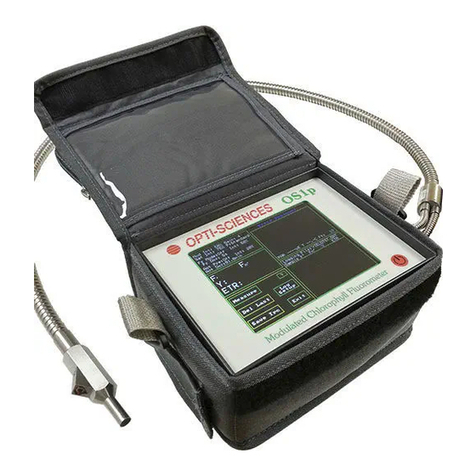
GFPIII operation manual Opti-Sciences, Inc.
7
Research regarding the use of ratio fluorescence to measure chlorophyll content has been established for
some time, and the limitations are well understood. However, until now, the cost of such systems has been
prohibitive.
With this technology, chlorophyll samples absorb a blue fluorescence excitation light, and emit a range of
fluorescing light at longer wavelengths. The research shows that by comparing the ratio of fluorescence
emission at 735nm and at 700 nm, there is a linear response to chlorophyll content. Since this method
does not compare transmission through a leaf at two different wavelengths, the measuring aperture does
not have to be completely covered. In addition, the fluorescence is measured on the same side of the
sample as the excitation light. For these reasons, fluorescence will work with leaves smaller than the
measuring aperture like immature rice and turf grasses. It will also measure samples with curved surfaces
like pine needles, and measure difficult samples like cactus, fruit, lichens, and filamentous algae on rocks.
In other words, this instrument is designed to work with all of the types of samples listed above, that are
a problem for existing absorption systems.
Opti-Sciences decided to use the research by Gitelson A. A., Buschmann C., Lichtenthaler H. K. (1999)
“The Chlorophyll Fluorescence Ratio F735/F700 as an Accurate Measure of Chlorophyll Content in
Plants” Remote Sens. Enviro. 69:296-302 (1999) as our blue print for the instrument design, because of
the excellent linear correlation with chemical testing, in a wide range of chlorophyll content 41 mg m-2 to
675 mg m-2 . The advantage of this ratio is that it works exceptionally well even above chlorophyll content
levels of 200 mg m-2 . By raising the lower fluorescent emission measuring range away from chlorophyll
absorption band near 680 nm or 685 nm, to 700 nm, the amount of fluorescence light that is reabsorbed
and emitted again as chlorophyll fluorescence is minimized, significantly extending the useful linear
measuring range of the instrument.
The instrument is called the CCM-300 chlorophyll content meter. It uses a fluorescence excitation
wavelength with a peak at 460 nm and a half band width of 15 nm. It measures two different emission
wavelength ranges at the same time, 730 nm to 740 nm, and 698 nm to 708nm.
The instrument also provides two different read-outs. One is the F735nm / F700 ratio reported by
Gitelson, and the other is a direct readout of relative chlorophyll content according to Gitelson’s formula.
The option also exists for changing some of the relative chlorophyll content formula parameters in case a
researcher should want to modify the formula for an unknown non-conforming plant species.
Measuring options include, single point measurement, averaging from between 2 and 30 samples,
averaging with 2 sigma outlier removal, and median value readout.
As with all things, it is also important to know a technique’s limitations, and these are detailed in Gitelson
1999. To a lesser degree, Buschmann C. (2007)” Variability and application of the chlorophyll
fluorescence emission ratio red/far-red of leaves.” Photosynthesis Res.(2007) 92:261-271. explores the
limitations of a different ratio technique that uses fluorescence near the peak of PSII fluorescence. The
ratio in Buschmann (2007) is F690nm /F735nm.





























